Hostile Fire
Some time ago I was talking to my daughter, who is also a Navy veteran. She was deployed to the Middle East during the Iraqi War. We were having one of those "What did you do in the war, Daddy" kinds of conversation. She asked me what I would pick as the most significant thing I had done in the Vietnam War. After some thought I answered by telling her the story of my taking an exploded and reassembled 152mm enemy artillery shell to Naval Headquarters in Saigon.
I am a combat veteran of the Vietnam War. I served in the Naval Advisory Group in 1968-1969. I was stationed in Cua Viet as the Intelligence Officer on the staff of Task Force Clearwater. We ran patrol boats on the Cua Viet and Perfume Rivers. Our job was to provide protection for the cargo boats taking supplies to the soldiers and marines upriver. That three month assignment in Cua Viet was followed by time in Saigon and then Danang.
The little base at the mouth of the Cua Viet River was bombarded by light to heavy artillery (85mm, 122mm and 152mm) on almost a daily basis. Over the three month period that I was the intelligence officer for Task Force Clearwater there were numerous attacks resulting in casualties, both deaths and injuries.
Each time we were hit I sent a report to Saigon of the incident with details of what we were hit with, casualties, damage, etc. Each time my report was disregarded or disparaged. Their response was that we were more likely hit with mortars or rockets.
Their reasoning went like this: The only place that the NVA could launch such artillery attacks was within the DMZ because the range of the NVA guns was not long enough to reach us from north of the DMZ. The DMZ by definition was demilitarized. Because it was demilitarized, there could be no artillery there. Ergo, Cua Viet could not be hit by artillery. So, I must be mistaken about what was hitting us.
After a particularly heavy bombardment one night in June 1968 an unexploded round was sighted with its nose sticking up through the hardpan of our loading dock. The Explosive Ordnance Demolition Team exploded the dud round. I picked up the pieces and put them together like a puzzle. Voila! - a 152mm artillery round, proof positive that we were indeed being hit with heavy artillery.
I asked the boss if I could take it to Saigon and he gave me permission. I put my reassembled 152mm round in a box and took another man with me to help me carry it because of the weight. We boarded a boat to Danang, hopped a flight on a Marine C-130, flew to Saigon, took the 152mm round to COMNAVFORV headquarters and plopped it down on the desk of the senior intelligence officer and said, "That's what they're shooting at us!"
One week later there was an Arc Light (B52) strike in the DMZ. We couldn't see the planes when they dropped their deadly load, but we felt the ground shake and saw the black smoke billowing skyward, a sight I will never forget. We were never hit with artillery again.
After I finished my little story, my daughter said, "Dad, just think what you did. There is no way to know how many lives you saved by what you did."
Now, I know it is nearly impossible to prove causality in the negative. When something doesn't happen that was expected, who can say for sure that it was the result of any preventative action taken.
After that conversation with with my daughter and her conclusion that my action saved many lives, I have had to reassess the importance and impact of my role in Vietnam.
Captain Herman Hughes, Ph.D.
US Navy Retired
PFC USMCR








